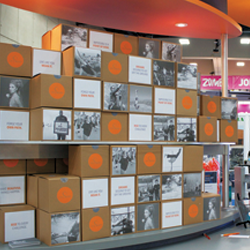|
exhibitor q&a
Help!
double decks
 Q.
We're thinking about adding a double deck to our exhibit. How do most exhibitors use these types of structures, and what do I need to know about them prior to signing on the dotted line?
A.
A double deck is a fantastic addition to many floor plans. Decks allow exhibitors to expand their available square footage without increasing floor-space costs, and they offer increased functionality in the form of everything from private meeting areas to VIP lounges. What's more, the sheer height and volume of a second-level structure can expand your show-floor presence, provide dramatic vistas for exhibit visitors, and help attendees spot your space from aisles away.But just as with any other booth component, you need a bit of background knowledge to ensure you're making a wise purchase (or rental). So here's a quick primer on decks, including everything from the functional options available to guidelines and regulations regarding their use. Fabulously Functional Almost every deck comprises a square or round construction with at least one attached staircase. You can then adapt this foundation to suit myriad objectives. For example, both the lower and upper levels can be enclosed or open; you can attach logos, infills, and graphics; and the upper level can be open to the public or restricted to select attendees or staff for activities such as autograph signings, VIP lounges, private demos for top prospects, and more. This limited-access application is particularly effective for exhibitors in the health-care and gaming industries, some of which have used their upper-level space to offer completely different experiences for different types of attendees. For example, they've provided international pharmaceutical information to foreign-based attendees on the upper deck and reserved the lower-level space for U.S.-specific information. Along these same lines, some gaming shows permit underage attendees to wander the show floor but forbid them from viewing adult gaming content. So some exhibitors have displayed such content on their upper decks and required proof of age in order for attendees to gain access. As you can see, then, there are many ways to use your overhead space. The key to employing it effectively is to clearly outline your goals and to talk with your designers about the best way to achieve them given the space and budget available. Own or Rent? Once you've decided to move forward with a deck, you're on to the next part of the process: determining whether to rent or buy. Your first step is to consider how many times you're going to use it. Many exhibitors only use their decks at the most important shows on their annual exhibiting calendars. If you buy a deck and only trot it out once a year, you're getting very little use out of it; plus, you're paying not only the initial cost but also ongoing storage costs. Generally speaking, unless you plan to use the second-story structure at three or more shows in a given year, or you need a unique shape that modular rental components can't accommodate, you're probably better off renting a deck than purchasing a custom structure. You can still brand a rented deck with custom graphics and accoutrements to make it your own. But more often than not, exhibitors find it more cost effective to rent rather than buy. And that brings up another point: modularity. A completely custom deck built from scratch is often a heavy monstrosity whose shipping, drayage, and installation charges will eat your program's budget in large vicious chomps. Although this is not always the case, the exceptions prove the rule. A deck built from modular aluminum components is typically lightweight and relatively easy to assemble. As such, it'll cost you less to ship, move, and install than its custom cousin. Plus, it can be reconfigured, customized with graphics and a variety of infills, etc. Again, your deck must meet your goals, but be certain to consider all associated costs before you opt for a custom solution. Guidelines and Requirements If a double deck meets your needs and you've decided between a custom and a rental option, what's left to consider? Actually, there are several variables related to the venue and show regulations. Your double-deck provider or designer should be responsible for ensuring your structure meets all of these requirements. But it's important that you, too, know what they are and that you discuss them with your design team. Here are some of the most important considerations: ► Space Requirements – Show rules often dictate that a double-deck exhibit requires a 20-by-20-foot space or larger, and at least a 20-foot clear height (i.e., the distance from the floor of your upper deck to the lowest underside point of the venue ceiling). Plus, many shows have a maximum height restriction for various booth sizes. For example, most in-line exhibits can extend no more than 8 feet tall, while island spaces can tower to 16 or even 30 feet. So verify the venue's ceiling height directly over your space (as height variances can exist within the same hall) and ensure that your structure meets the regulations governing booth size and height. ► Weight Capacities – Along these same lines, your deck must be fit to handle the weight load you intend to place upon it. For example, do you plan to host no more than 10 people in a meeting room upstairs, or might you try to fit 30 people into that space for a demo presentation? Your designers need to consider weight capacities when planning your upper-level space, but your booth staff also needs to keep this capacity in mind during the show. Failing to do so could result in hefty fines from the venue's fire marshal. ► City, Venue, and Trade Show Regulations – While most deck-related regulations are common across the country, some rather strict codes are more venue or location specific. For example, the Las Vegas Convention Center mandates two staircases on any double-deck structure measuring more than 300 square feet, and if your structure is more than 1,000 square feet, you need a sprinkler system on the lower level. In several Pacific Northwest cities, the deck must meet local earthquake codes. Investigate double-deck regulations for every show and venue as opposed to assuming that a deck approved for one show is good to go at all others. Americans With Disabilities Act Guidelines – There's a bit of gray area surrounding the wording and enforcement of ADA requirements. But generally speaking, anything you provide upstairs should also be available to people (or at least the same type of attendee, e.g., a VIP, international physician, etc.) on the ground floor. Few hard and fast "thou shalt nots" are ever stated in exhibitor manuals, but compliance with the spirit of ADA is encouraged – and failure to accommodate everyone could ultimately result in a lawsuit. As you can see, double decks can help you achieve a host of marketing and customer-experience objectives. But before you go all in on an upper deck, be sure it fits your needs and budget and that your exhibit designers have addressed all regulations governing its use. Armed with this knowledge, you should be all geared up for a double deck.
E — Debbie Parrott, president, Highmark TechSystems, Fort Wayne, IN
Help Wanted Send your tough questions about exhibiting to Linda Armstrong, larmstrong@exhibitormagazine.com.
|
|
|
||||||||||||||||||||||||||||
|
|
||||||||||||||||||||||||||||
|
TOPICS Measurement & Budgeting Planning & Execution Marketing & Promotion Events & Venues Personal & Career Exhibits & Experiences International Exhibiting Resources for Rookies Research & Resources |
MAGAZINE Subscribe Today! Renew Subscription Update Address Digital Downloads Newsletters Advertise |
FIND IT Exhibit & Display Producers Products & Services All Companies Get Listed |
EXHIBITORLIVE Sessions Certification Exhibit Hall Exhibit at the Show Registration |
ETRAK Sessions Certification F.A.Q. Registration |
EDUCATION WEEK Overview Sessions Hotel Registration |
CERTIFICATION The Program Steps to Certification Faculty and Staff Enroll in CTSM Submit Quiz Answers My CTSM |
AWARDS Sizzle Awards Exhibit Design Awards Portable/Modular Awards Corporate Event Awards Centers of Excellence |
NEWS Associations/Press Awards Company News International New Products People Shows & Events Venues & Destinations EXHIBITOR News |
||||||||||||||||||||
|
||||||||||||||||||||||||||||






